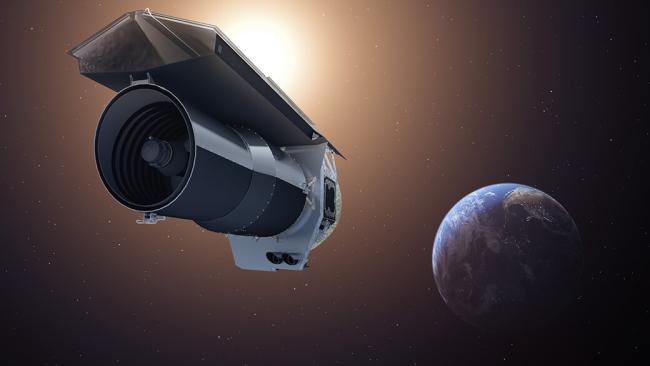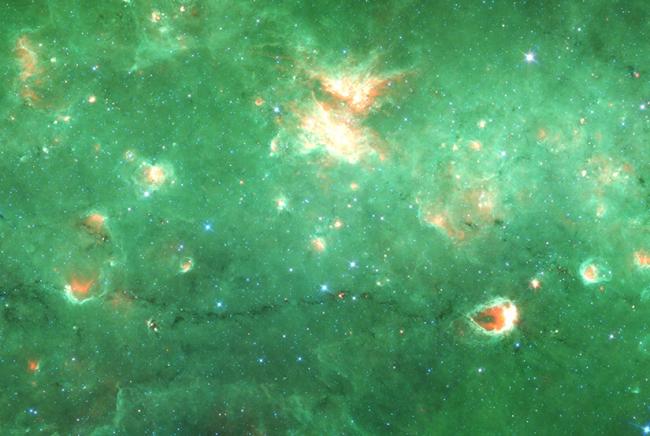Spitzer Space Telescope
Infrared light is the key to studying a wide range of astronomical systems, including newborn stars and planets, dust in distant galaxies, and material swirling around black holes. The Spitzer Space Telescope was NASA’s orbiting infrared observatory, and part of NASA’s Great Observatories program, along with the Chandra X-ray Observatory and the Hubble Space Telescope. Scientists and engineers at the Center for Astrophysics | Harvard & Smithsonian led the design, testing, and construction of the Infrared Array Camera (IRAC). The Spitzer Space Telescope was launched in 2003 and retired in 2020.

Artistic rendition of NASA's Spitzer Space Telescope in position to establish communications with Earth. Spitzer is 210 million kilometers (130 million miles) away from Earth, or about 1.5 times the distance between Earth and the Sun.
The Telescope and the Science
The Spitzer Space Telescope was named in honor of astrophysicist Lyman Spitzer, who promoted the idea of orbiting observatories in the 1940s. Launched into space in 2003, the observatory was the final NASA Great Observatory to be put in service, following the Hubble Space Telescope, the Chandra X-ray Observatory, and the now-inoperative Compton Gamma Ray Observatory. Unlike the other Great Observatories, Spitzer orbited the Sun directly at a distance far enough from Earth to keep our planet’s infrared light from interfering with observations.
As an infrared observatory, Spitzer collected light from regions of space that are hidden from optical telescopes, and it could detect light emitted from cooler objects. For example, Spitzer was able to peer through interstellar dust clouds that are both home and raw materials for star and planet formation. Scientists also used Spitzer to identify molecules and temperature variations in the atmospheres of giant exoplanets, spot brown dwarfs in orbit around other stars, and to identify supermassive black holes in distant galaxies by the matter swirling around them.
CfA astrophysicist Giovanni Fazio led the team that proposed, designed, built, and tested Spitzer’s main infrared camera IRAC, which took images at wavelengths between 3.6 and 8 millionths of a meter. Other contributors to IRAC included NASA’s Ames Research Center and Goddard Space Flight Center, the University of Arizona, and the University of Rochester. The IRAC science team is located at the CfA and worked with the operations center at Caltech.
Spitzer’s original observation program was intended to last two and a half years, but the telescope performed well enough to continue operating well past that deadline. Of Spitzer’s original three instruments, only IRAC operated after the exhaustion of its cryogenic helium supply until the telescope was retired in January 2020. The other two instruments were: the Infrared Spectrograph (IRS), for measuring the spectrum of infrared light at a wider range of wavelengths; and the Multiband Imaging Photometer for Spitzer (MIPS), which operated at the long-wavelength end of the infrared spectrum.

Astronomers used NASA's Spitzer Space Telescope to identify the first "bone" of the Milky Way, the dark tendril of dust and gas in this image. The "bone" is a type of filament that makes up structures seen in other spiral galaxies.
- How do stars and planets form and evolve?
- Does life exist outside of the solar system?
- Why do galaxies differ so much in size, shape, composition and activity?
- Quasars & Other Active Black Holes
- Machine Learning
- Astro Combs
- STEM Education Research
- Planetary Geology
- Solar and Stellar Atmospheres
- Atomic & Molecular Data
- Cosmic Microwave Background
- Gravitational Dynamics
- Cosmology
- The Energetic Universe
- Planetary Systems
- Stellar Astronomy
- The Milky Way Galaxy
- Extragalactic Astronomy